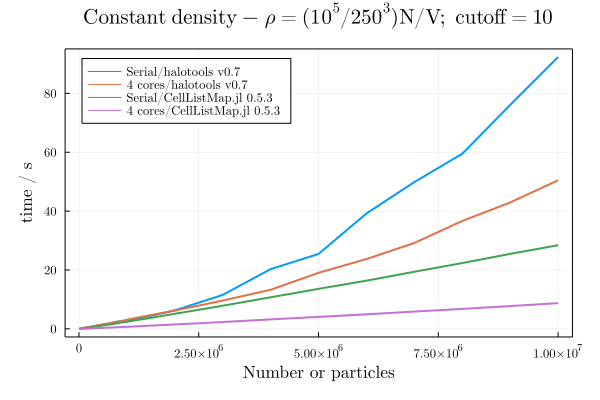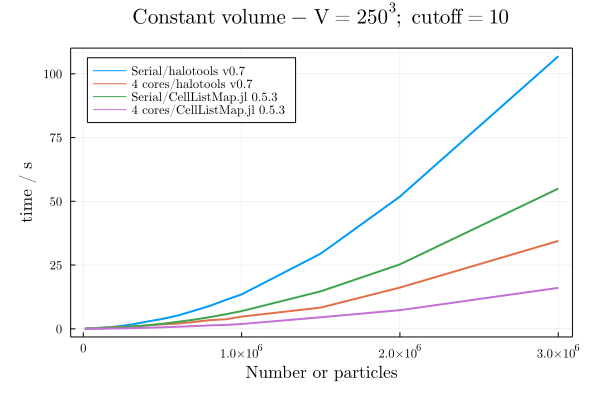CellListMap.jl
This package is for computing interactions or any other property that is dependent on the distances between pairs of two- or three-dimensional particles, within a cutoff. It maps a function to be computed pairwise using cell lists, using periodic boundary conditions of any type. Parallel and serial implementations can be used.
It allows the fast computation of any quantity from the pairs that are within the desired cutoff, for example pairwise potentials and forces, neighbor lists, minimum distances, an average distance or an histogram of distances, etc. This is done by passing the function to be evaluated as a parameter of the map_pairwise! function.
The user guide provides direct examples of each of these applications.
USER GUIDE:
https://m3g.github.io/CellListMap.jl/stable/
https://m3g.github.io/CellListMap.jl/stable/
Installation
Install it as usual for registered Julia packages:
julia> import Pkg
julia> Pkg.add("CellListMap")
Brief overview
The main function is map_parwise!:
If the analysis is performed on the pairs of a single vector x (n*(n-1)/2 pairs), the function can be called with:
map_pairwise!(f::Function,output,box::Box,cl::CellList)
while if two distinct sets of points are provided (n*m pairs), it is called with:
map_pairwise!(f::Function,output,box::Box,cl::CellListPair)
where the cl variable of type CellList or CellListPair contains the cell lists built from the coordinates of the system, and box contains the system box properties.
These functions will run over every pair of particles which are closer than box.cutoff and compute the (squared) Euclidean distance between the particles, considering the periodic boundary conditions given
in the Box structure. If the distance is smaller than the cutoff, a user defined function f of the coordinates of the two particles will be computed.
The function f receives six arguments as input:
f(x,y,i,j,d2,output)
Which are the coordinates of one particle, the coordinates of the second particle, the index of the first particle, the index of the second particle, the squared distance between them, and the output variable. It has also to return the same output variable. Thus, f may or not mutate output, but in either case it must return it. The squared distance d2 is computed internally for comparison with the cutoff, and is passed to the f because many times it is used for the desired computation. Thus, the function f that is passed to map_pairwise! must be always of the form:
function f(x,y,i,j,d2,output)
# update output
return output
end
and the user can define more or less parameters or additional data required to compute the function using closures, as shown in the examples.
Parallel calculations are the default if more than one thread is available. Use parallel=false as an optional argument to map_pairwise! to run the serial version instead.
Some benchmarks
The goal here is to provide a good implementation of cell lists. We compare it with the implementation of the nice cython/python halotools package, in the computation of an histogram of mean pairwise velocities.


The full test is available at this repository. And we kindly thank Carolina Cuesta for providing the example. These benchmarks were run on an Intel i7 8th gen laptop, with 4 cores (8 threads).
Citation
If you use this software and need to cite it, please use the following reference:
Martínez, Leandro. (2021, June 11). CellListMap.jl: Flexible implementation of cell lists to map the calculations of short-ranged particle-pair dependent functions, such as forces, energies, neighbor lists, etc. Zenodo. http://doi.org/10.5281/zenodo.4927541